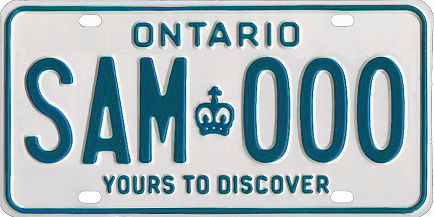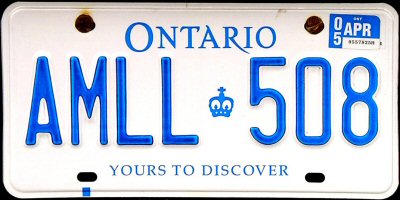Welcome to our course
Welcome to the Mathematics of Data Management. In this course you will organize and analyse data, solve problems and communicate results, and in a culminating assignment apply what you've learned to new problems in statistics and probability. This course is divided into four units: Counting, Probability & Data, Statistics, and Distributions.
Counting
In this first unit, you will develop a foundation for later study in probability and statistics by learning about organized counting. By applying mathematical principles to a situation, we can calculate results accurately and communicate our findings clearly.
Yours to discover
In 1997, the Province of Ontario introduced a new series of licence plates for cars. These plates have an identifier consisting of four letters followed by three numbers. Leading up to that, our licence plates had three numbers followed by three letters. The following pictures depict some of the iterations of Ontario licence plates over time.




Think
Before continuing, consider the following two questions. Press 'Show Suggested Answer' to check your answer or thought process.
- Why do you think they switched from 6 character licence plates to 7 character licence plates?
They switched from 6 characters to 7 in order to have many more unique plates they can issue.
- Do you think the total number of different licence plates possible would be closer to 0.1 million, 1 million, 10 million, 100 million, or 1 billion?
The total number of different licence plates possible is closer to 100 million than the other numbers listed.
Throughout this course you'll encounter Suggested Answer buttons like these. A suggested answer is just that - a suggestion. If you came up with a different answer, compare it carefully and thoughtfully to the suggested answer. How different is it? Does it still show all of the expected knowledge? If so, you're succeeding and can proceed. If it's still different, take a moment to think about the problem again. What other information can you gather?
In this learning activity we will analyze a topic called combinatorics and the fundamental (multiplicative) counting principle and how it is used to determine the total number of outcomes possible in a situation. We will also examine creating a tree diagram to count and organize possible outcomes.
What is combinatorics?
Combinatorics is the branch of mathematics that deals with calculating the number of possible outcomes in situations. Essentially it's how to count, especially when there are a lot of outcomes. This tells you what is possible. Once you know what is possible, statistics can be used to determine the likelihood that a particular outcome will occur out of all of the possible outcomes. This comparison is called the probability of the particular event occurring (or “how likely” an event is).
One of the main rules you will use in solving counting problems is the fundamental (multiplicative) counting principle.
The fundamental (or multiplicative) counting principle is used to determine the number of outcomes that are possible in a given situation. This principle states that the number of ways to make two choices is the product of the ways to make each individual choice. If there are 'm' ways to make one decision, and 'n' ways to make another decision, the number of possible outcomes after making both decisions is .

Consider this example.
Kiana (she/her) wants to order a cake from a bakery. She has the choice of 3 flavours of cake: lemon, chocolate, or carrot and the choice of 2 flavours of icing: vanilla or cream cheese. We want to find out how many different cakes she could order.
To start, we'll try two different strategies to count. The first is tree diagrams, and then we'll apply the fundamental counting principle.
To draw a tree diagram for a combinatorics problem, pick your starting point. Write all the possible outcomes of your first decision, and connect them to your starting point. From each of those outcomes, draw more branches to represent the outcomes of your second decision.
In our example, Kiana can first decide on a flavour. Our three options are lemon, chocolate, and carrot, so they're written to the right of the starting point. Once she's picked a flavour, she can then select a frosting: vanilla or cream cheese.

Press here for long description(Open in new window)
In a tree diagram, we can count the possible outcomes by counting how many branches there are on the far right side. In Kiana's case, there are six branches: lemon vanilla, lemon cream cheese, chocolate vanilla, chocolate cream cheese, carrot vanilla, and carrot cream cheese. So there are 6 possible cakes!
Our other option was to use the fundamental counting principle. Kiana is making two choices. The first, flavour, has three options. The second choice, icing, has two options. The number of ways to make both decisions, then, is 3 × 2 = 6. There are, again, 6 possible cakes.
Notebook
Set up your notebook
While working through this course, you will need one other tool to help you stay organized. You will need a “notebook.”
This may be an actual pen and paper notebook where you can take notes and write reflections as instructed throughout the course. Alternatively, you may choose to have a digital “notebook” or a file where you type your notes and reflections. This is a personal decision, but it is important that you have a consistent place for your notes. Your notebook is only for your own reference, so keep it in a way that makes sense to you, and will continue to make sense as you progress through the course.
Be sure to add a title to each set of rough notes with the unit you are working on, learning activity title and number. Spelling does not matter in these rough notes, but the act of completing these reflections and quick activities is important for your learning.
You will encounter questions throughout the course that ask you to pause and reflect on your learning, or to self-check. Record these questions and your answers in your notebook, then compare your response to the suggested answer if one is provided. Any differences are an opportunity to learn more, but as they are just suggestions they do not mean your answers are wrong. Think about your response, and ask a trusted friend or family member, search online, or contact your TVO ILC academic support team if needed.
Choices, choices, choices
Kiana demonstrated that we can use the fundamental counting principle to make two decisions. But what if there are more?
Try it!
Alex (they/them) needs to pick an outfit for work. They have three shirts to select from (white, yellow, and blue), three pants to select from (black, grey, and brown), and two ties (purple and pink). Use a tree diagram to determine how many different outfits they could wear.

Press here for long description(Open in new window)
Counting the right-side options, there are 18 different outfits.
Note that 18 = 3 × 3 × 2
The fundamental counting principle can be applied no matter how many decisions are being made. To find the number of possible outcomes after making different decisions, multiply together the number of options for each decision.
Cody (he/him) is making a series of decisions. The first decision has 8 options, the second decision has 23 options, the third decision has 2 options, and the fourth decision has 19 options. How many different outcomes are there?
8 × 23 × 2 × 19 = 6992.
There are 6,992 different outcomes.
Practice question
Press 'Show Suggested Answer' to check your work.
Now that we have explored how a tree diagram or the multiplicative counting principle can be used to determine total possible outcomes, let’s apply it to the Minds On problem with the licence plates.
Let's assume that there are no restrictions on licence plates. The four letters can be any of the 26 letters in our alphabet, and the three numbers can be any of the 10 digits. How many different plates are possible given the current pattern in Ontario of 4 letters followed by 3 numbers?
There are 26 letters in the alphabet (we are assuming no letters are excluded). The first part of the calculation would be 26 × 26 × 26 × 26.
There are 10 different digits from 0 to 9 (we are assuming no digits are excluded). The next part of the calculation would be 10 × 10 × 10.
Together the total number of licence plates possible is:
26 × 26 × 26 × 26 × 10 × 10 × 10 = 456,976,000.
Therefore, there are 456,976,000 different licence plates possible with 4 letters followed by 3 numbers.
This is a big increase from the earlier licence plate pattern of 3 letters followed by 3 numbers. The calculation for the total number of licence plates possible in that situation was
26 × 26 × 26 × 10 × 10 × 10 = 17,576,000.
By including a spot for an extra letter the total number of licence plates possible increased by 439,400,000.
The fundamental counting principle is one rule we can use to count efficiently. In this unit, we'll learn some more. It's not that this is brand new information, or something you couldn't have figured out yourself, but rather a formal statement that enables us to use it in future work. At its core, that's what mathematics is. Start with an assumption or observation, and figure out what you can know based on that. In this case, we started with an observation of decisions being made, and determined a new fact: the fundamental counting principle.
One of the additional supports that you have in this course to help you with a more personalized math learning experience is TVO Mathify(Open in new window). Mathify offers an online whiteboard workspace that can be accessed from anywhere. Mathify also offers free online tutoring from Ontario certified teachers through a shared whiteboard, texting, and/or audio chat. You can open a whiteboard at any time and use it as a workspace. Then, you can invite the tutor of your choice to your whiteboard when you need help, encouragement, or advice. If you are new to Mathify, take the time to get registered and explore this service and the scheduled tutoring hours. You will require an Ontario Education Number (OEN) to create your accout. Select "TVO Board" for the "School Board/Organization".
Note: Mathify is for learners in Ontario
To prepare for a Mathify tutoring session, do as much work as you can and have one specific question ready. Try your best, and ask for support if you get stuck. Your tutor will guide you on some strategies, which you can then try out independently.
Self-check
In this learning activity we have learned how to create a tree diagram for organized counting of outcomes, and how to use the fundamental (multiplicative) counting principle to determine the number of possible outcomes of a particular situation.
Complete the following questions. You may choose to use the following link to log in to Mathify and use a Mathify whiteboard to complete the questions. Learning Activity 1.1 Whiteboard(Open in new window). Mathify is for learners in Ontario. You may also complete the following questions directly in your notebook. Once you are done, compare your responses to the suggested answers provided.
Practice questions
After answering the following questions in your notebook, check your answers with those provided.
- Talia (they/them) has just purchased some new clothing items and wants to determine how many different outfits they can make by mixing and matching these new pieces. They have:
2 pairs of socks (grey, black)
4 pairs of pants (jeans, dark blue, plaid, striped)
2 shirts (green, white)
- Create a tree diagram to show the total number of outfits, each needing socks, pants and shirt.
- Calculate the total number of outcomes using the fundamental (multiplicative) counting principle.
a. tree diagram

Press here for long description(Open in new window)
b. Number of different outfits: 2 (socks) × 4 (pants) × 2 (shirts) = 16 different outfits are possible
- Create your own question that has at least 2 parts/stages of choice.
- Create a tree diagram to show the total number of outcomes.
- Calculate the total number of outcomes using the fundamental (multiplicative) counting principle.
Answers will vary. Observe question 1 for ideas.
- Research Ontario licence plates. Are there actually 456,976,000 different licence plates possible in Ontario? We assumed there are no restrictions on letters and numbers, but there may actually be some restrictions. If so, what are they? Can you determine how many different licence plates are actually possible?
The letters G, I, O, Q, and U are not used. G, I, and Q can be mistaken for numbers. U can be mistaken for V. O can be mistaken for a number and for the letter D. There are also many combinations that are eliminated because they can be considered offensive. Calcuating the number of plates available considering the eliminated letters is 21 × 21 × 21 × 21 × 10 × 10 × 10 = 194,481,000.
- Add any new terms to your notebook. Use this as the start of an ongoing glossary through the course.
Answers will vary. Some suggestions are: fundamental counting principle, multiplicative counting principle, tree diagram, combinatorics, outcomes.
Self-check quiz
Check your understanding!
Complete the following self-check quiz to determine where you are in your learning and what areas you need to focus on.
This quiz is for feedback only, not part of your grade. You have unlimited attempts on this quiz. Take your time, do your best work, and reflect on any feedback provided.
Press Quiz to access this tool.
Reflection
To determine your understanding of the concepts in this learning activity reflect on these success criteria. Are you able to…?
- use the fundamental (multiplicative) counting principle to determine the number of outcomes possible
- create a tree diagram to show the number of outcomes possible
- solve problems involving the calculation of the total number of outcomes possible
The culminating assignment
At the end of this course, you will complete and submit a culminating assignment. You'll have the opportunity to do some work and get feedback on this assignment during the course, but the final submission will happen at the end. To review the final assignment now, press on the following: 4.6 Assignment: Culminating Investigation(Open in new window) Refer back to the assignment as you work through the course, as you may be able to make some progress on it early.
If needed, go back and read through the relevant examples. If you still have questions please message your academic support team or seek out additional examples on line.
Connecting to transferable skills
Ontario worked with other provinces in Canada to outline a set of competencies that are requirements to thrive. Ontario then developed its transferable skills framework as a set of skills for students to develop over time. These competencies are ones that are important to have in order to be successful in today’s world.
Read the following document entitled Transferable Skills Outline (Opens in new window) to explore the framework and the descriptors for each skill. Download, print, or copy the information in the document into your notes - you'll refer to it in each unit.
Note the indicators that you think you will develop in this course. At the end of the course you will revisit these skills to see which ones you actually developed and if your original predictions were correct.
As you continue through this unit and the rest of the course, keep your notebook updated and be mindful of opportunities to apply and develop transferable skills.
In the next learning activity, you will add another organized counting tool to your inventory: permutations.


